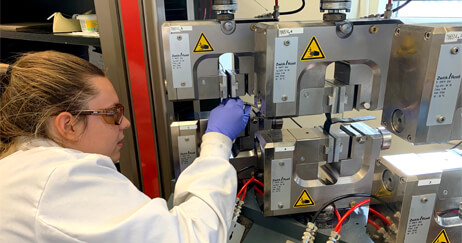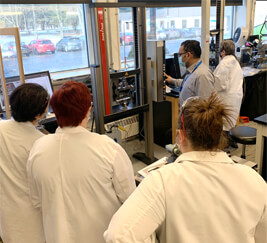Dynamometer testing is used to evaluate the mechanical strength of a textile or geosynthetic product. Textiles for protective clothing, such as firefighter uniforms, work uniforms, or military clothing, must be dynamometer tested to ensure their mechanical strength.

Validation of geotextile welds

Dynamometry on geosynthetics

Training of our staff on dynamometry equipment
Other more technical textile products, such as straps, ropes or harnesses, are also often subjected to dynamometry tests for safety reasons.
Geosynthetics also require their share of dynamometric characterization: geomembrane welds, geotextile seams, hydrostatic punching, tears or bursting of geomembranes and geotextiles.
The various dynamometry tests include characterizations under several constraints, chosen according to the application of the developed product:
- Tension (ASTM D5034, ASTM D5035, ASTM D4885, ISO 10319);
- Shear and tear (ASTM D4533, ASTM D5884);
- Compression (ASTM D6364);
- Punching (CAN/CGSB 4.2 No 11.2, TP 1324, ASTM F2878, ASTM D4833, ASTM D6241);
- Impact on soft materials (ASTM D1790);
- Creep (to measure the irreversible deformation of a material under stress).
Note: most of these tests can be performed in a standardized environment, or at high or low temperature (down to -90°C).
At CTT Group, it is also possible to evaluate the behavior of a material subjected to other mechanical stresses in order to evaluate the cut resistance (ASTM F2992, ASTM F1790 or ISO 13997), Martindale abrasion resistance (ASTM D4966) or Stoll abrasion resistance (ASTM D3885, ASTM D3886), or Taber abrasion (ASTM D3884) for the development of personal protective equipment.






